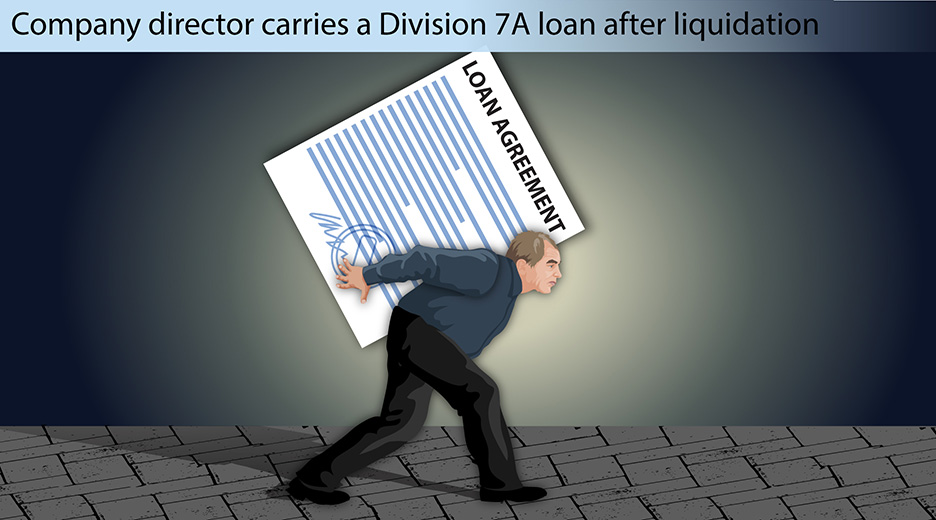What happens to a Division 7A loan in a winding up?
In a winding up, it is the duty of the liquidator to realise all assets of the company. This includes outstanding loans to shareholders and directors. In this article, we explain what happens to some of these loans — loans that comply with Division 7A of the Income Tax Assessment Act 1936 (Cth) — in the winding up of a company.

It is common for directors and shareholders of companies in Australia to withdraw company funds through a loan account. In this article we look at when these loans are permitted, and when they will be treated as deemed (and unfranked) dividends. We also look at what happens to these loans on the winding up of a company.
Why do companies make loans to directors and shareholders?
In the smaller companies that make up the bulk of the Australian economy, it is quite common for directors/shareholders (commonly the same person or people) to draw on company funds through a loan account, rather than a salary or dividends. This action is usually taken in order delay tax liability (since a salary would be taxed immediately, and dividends taxed annually), and frees up cash flow.
However, there are risks in doing this:
- Poor financial record-keeping in many small businesses means that it can be easy to lose track of how much has been loaned
- In the case of liquidation, the loan will be called in by the liquidator and immediately payable (it’s an asset on the balance sheet)
- In the case of insolvent liquidation, there is a risk that loaned amounts could be seen as an ‘unreasonable director-related transaction’, and voided by the liquidator.
In many cases, the more prudent route for a director will be to pay themselves a reasonable salary, and with any excess profits, either re-invest in the business, or take them as franked (imputed) dividends.
How does Division 7A regulate loans from companies?
Division 7A of the Income Tax Assessment Act 1936 (Cth) sets out the rules for private companies where they make loans to shareholders or their associates.
Two elements worth noting are:
- In applying to ‘associates’ of shareholders, it applies to a wide range of individuals and entities, including loans made to relatives and partners of shareholders, trustees and related companies
- It doesn’t just apply to monetary payments, but loans of any assets, such as vehicles or equipment.
In short, Division 7A provides that where a company has made an unsecured loan to a shareholder or associate it is required to either:
- Repay the loan to the shareholder or associate within seven years, or
- Include the amount of the loan in the shareholder’s or associate’s assessable income as a deemed dividend.
What are the conditions for Division 7A loans?
Looking at the loan conditions in detail, in order be a qualifying loan under Division 7A, (a ‘Division 7A loan), and for the amount not to be taxable income of the shareholder, the loan must meet strict conditions — referred to by the Australian Tax Office (ATO) as a ‘complying loan’. The key conditions are:
- A minimum interest rate. The interest rate for each year must be equal to or higher than the ‘benchmark interest rate’ set by the Reserve Bank of Australia (RBA)
- Maximum term. The maximum term of the loan is 25 years for a loan secured by a mortgage over real property. Note, this mortgage must be registered, and the market value of the secured property must be at least 110 percent of the value of the loan at the time the loan is made. Where the loan is unsecured, the maximum term is 7 years.
- A written agreement. A written agreement is required before the income lodgment date for the year in which the amount was paid. The written agreement can be drafted to cover future loans. This agreement, should, at minimum:
- identify the parties to the loan;
- set out essential terms of the loan, including the amount and term, a requirement that the loan be repaid and the applicable interest rate
- be signed and dated by the parties.
If these conditions are not met, the ATO can judge the loan(s) a deemed (unfranked) dividend of the shareholder, which is subject to income tax without the corresponding franking credit. These issues often come up through ATO audits.
What happens to a Division 7A loan agreement on liquidation?
In an insolvent liquidation, a liquidator can call in a Division 7A loan. If it is not repaid, the shareholder can be pursued personally (even to the point of bankruptcy). Therefore a director faced with this situation should either repay the loan or negotiate terms with a liquidator.
Alternatively, where the company has been profitable quite recently, and has franking credits available (also known as ‘imputation credits’), it may be possible for the company to declare a dividend, and for the shareholder to applying the franking credit (thereby reducing/eliminating their income tax liability). Of course, usually the company will not have been profitable recently, so no such franking credits will be available.
It is worth noting that where the loan becomes a dividend it will create a tax liability for the director or shareholder.
Division 7A loans in liquidation
It is relatively common for shareholders/directors of small companies to use loans rather than salaries/dividends to draw earnings from a company. However, in doing so, it is crucial to follow Division 7A loan requirements. If these are not followed, amounts become a deemed dividend on which the recipient owes tax.
Where the company is placed in insolvent liquidation, outstanding division 7A loans are an asset on the balance sheet and will be called in by the liquidator in realising assets.